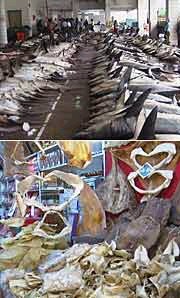|
"Improved monitoring at the local level in key seafood trading centers like Hong Kong could help correct inaccurate information used to manage or regulate fishing levels," she said. "Although I don't believe that trade data will ever be more important than fisheries monitoring data."
Key Market
Hong Kong's busy Sai Yun Pun district serves as the center of global trade in shark fins, which are considered a delicacy in many Asian diets. To harvest shark fins, fishers ply the world's ocean. Some definned sharks are fully utilized. Other sharks are caught solely for their fins. They are caught, finned by fishers, and returned to the ocean, where the shark bleeds to death. Fins are later salted and dried for sale to consumers.
Estimates suggest that Hong Kong handles 50 to 85 percent of the world's shark fin imports. Between 1996 and 2000, shark fin trade grew more then five percent a year in Hong Kong. (However 2001 figures show significant decreases in both Hong Kong and worldwide trade volume, and may reflect a new trend.)
Clarke's focused her research in the Sai Yun Pun district on shark fins and other dried seafood species, such as abalone and sea cucumbers, that had measurable trade records. Clarke found significant differences between the recorded trade numbers of shark fins in Hong Kong and key trading partners—particularly the enormous market of mainland China.
Clarke suggested the differences were rooted in inaccurate and changing reporting systems, rather than intentional manipulation. Nevertheless, the research led Clarke and her colleagues to estimate that other jurisdictions could also be significantly underreporting trade figures by 24 to 49 percent as compared to Hong Kong.
Soaring Demand
Growing human populations and improved fishing technology have placed marine animals under siege across the world's oceans. Managing these threatened resources poses a challenge that begins with acquiring accurate data on the nature and scope of the problem. Resources managers seek to answer such questions as, what species are being fished and how much are fishers catching?
Adele Crispoldi and Stefania Vannuccini, fishery statisticians at the FAO, note that incomplete, inaccurate, and delayed reporting makes gathering accurate statistics a challenge for the organization. FAO gathers its information from national fishery reports filed by member nations.
"Even though FAO statistics are the most exhaustive data available on world production and trade of fish and fishery products, they are also likely to underestimate the actual world production and trade volumes of specific species and products, such as sharks," the pair said in an interview. "Some data may be misleading if employed to deduce the respective importance, or trends for, various [shark] products."
FAO staff have since revised their initial estimates to reflect substantial increases to their estimated volume of shark fin trade in 2000 and 2001. Such revisions are not atypical. FAO staff say they often refine analysis of previously collected national fisheries data. (However, overall 2001 trade levels declined, outside researchers note.)
Cripoldi and Vannuccini said that steps to improve fishery statistics on sharks include developing better methods to gather data on fishing takes and increasing fishery observer programs. FAO is undertaking such initiatives as part of the organization's international shark conservation and management plan.
Because such plans are sometimes difficult to implement, the use of trade statistics to monitor fishing takes holds promise.
" They often provide a basis for supplementing, controlling, and validating catches through data sources not directly related to fishing," Crispoldi and Vannuccini said.
Crispoldi and Vannuccini noted one shortcoming: Trade statistics often fail to identify specific shark species.
Asian Demand High, Conservation Awareness Low
Throughout much of East Asia, dried seafood is both a popular food source and ingredient used in traditional medicines. Demand for dried seafood in China alone, with a population of 1.3-billion, is enormous.
Shark fin, known in China as yu chi or "fish wing," is used to make shark fin soup— a delicacy widely consumed in China since at least the start of the Sung dynasty in 960 A.D.
Trade in shark fins is a lucrative business. Depending on the species, shark fins can sell for U.S. $400 per kilogram (U.S. $880 per pound) or more in Hong Kong. Some 30 to 40 species are commonly traded.
Sharks were once ignored by many commercial fishermen. But they've become more desirable as other fish species disappear due to over-fishing. Sharks reproduce slowly. As a result shark stocks are slow to rebound once their populations have been diminished.
Shark fins from Europe now dominate the Hong Kong shark fin import market, according to the WCS study. While European imports were negligible as recently as the early 1990s, they now account for about 27 percent of the total figure. Nearly all of those sharks are harvested by Spanish fishing fleets, whose other traditional commercial fish species have declined.
In the Sai Yun Pun district, Clarke found that most dried seafood traders had little knowledge of the natural history of their trade goods or the conservation issues surrounding them. "The trade community as a whole is pretty unaware," said Clarke. "The traders in abalone and sea cucumber didn't have any sense of whether they were taking too many of the organisms, and whether 10 years down the line there might not be much left. That's a new concept for them."
Clarke said shark fin dealers were more aware of conservation efforts. "They know that people are trying to curb that trade, but they don't believe that there's a problem with shark numbers."
Clarke hopes that her trade-based approach can become a valuable tool in global efforts to conserve marine resources.
Top
|
